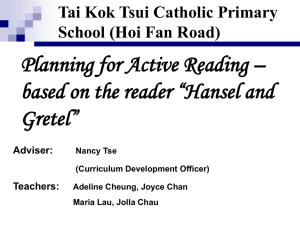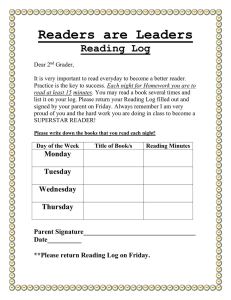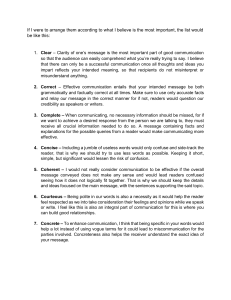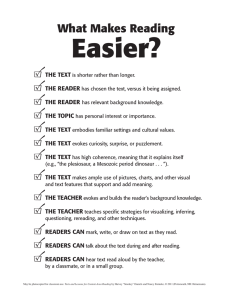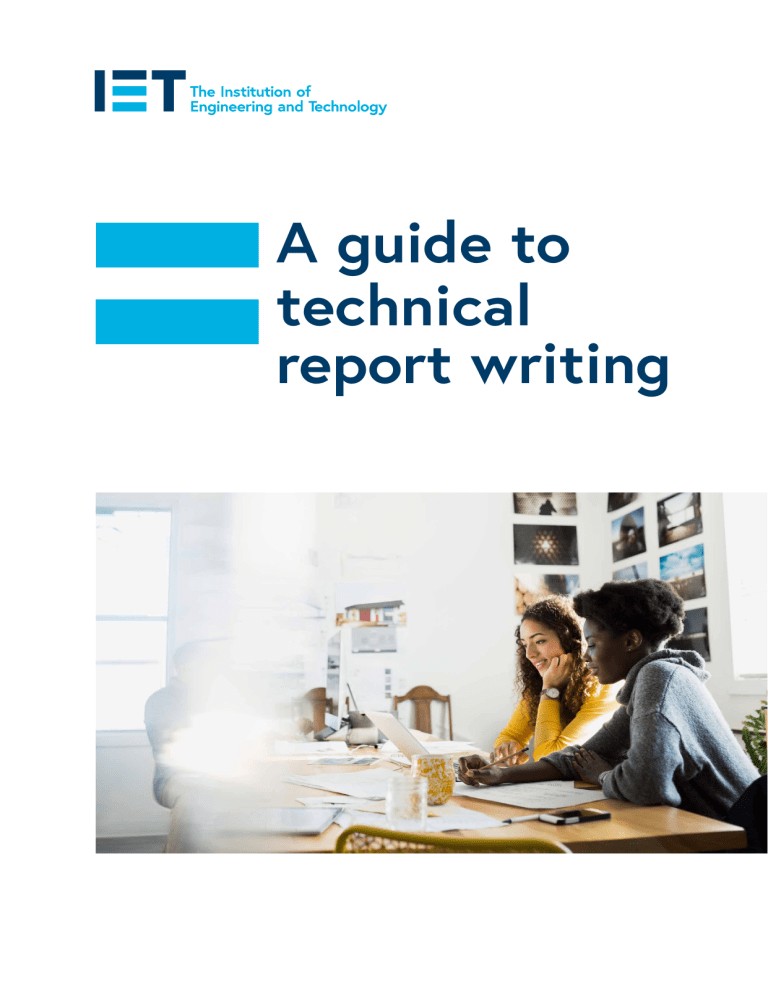
A guide to technical report writing A guide to technical report writing – Contents Contents 1. What makes a good technical report? 3 2. Objectives 4 2.1 Who are you producing the report for? 4 3. Format 5 3.1 Appendices 3.2 Sections and subsections 3.3 References 5 5 6 4. Writing 7 4.1 Spelling 4.2 Punctuation 4.3 Sentences 4.4 Paragraphs 4.5 Formality 4.6 Example 7 7 7 8 8 8 5. Diagrams 9 5.1 Positioning 5.2 Tables 5.3 Graphs 5.4 Diagram references 9 9 9 9 6. Finishing the report 10 6.1 Summaries 6.2 Abstracts 6.3 Table of contents 6.4 Title page 6.5 Appearance 6.6 Checking 10 10 10 10 10 10 7. Resources 11 02 A guide to technical report writing – What makes a good technical report? A Guide to Technical Report Writing was originally written by Joan van Emden and the late Jennifer Eastel and has been revised by the IET, with input from Alex Kerr who delivers this course on behalf of the IET. 1. What makes a good technical report? A good report is easy to recognise. Its title is precise and informative and its format logical to the reader, with headings to indicate the content of each section. Diagrams are well-presented and clearly labelled. Keep these rules in mind and you will be more likely to attract readers, direct them towards relevant, clear information and steer them towards the desired response. There are no absolute rules on report production because every report must be adapted to the needs of its reader. This guide, however, suggests that there are laws of good report writing which should be generally applied (but broken if necessary). Notice that the first law is repeated because it’s a law which shouldn’t be broken. Taking shortcuts to save time and money are counterproductive if your reader is left confused by the report or decides it’s too difficult to work out what you are trying to say. 10 laws of good report writing 1. produce the report for your reader(s) 2. keep the report as short as possible 3. organise information for the convenience of the reader 4. include accurate references 5. ensure your writing is accurate, concise and straightforward 6. include diagrams with the right labels in the right place for your reader 7. make sure your summary gives the whole picture in brief 8. check the report for technical errors, typing errors and inconsistency 9. consider design as well as content 10. produce the report for your reader(s) 03 A guide to technical report writing – Objectives 2. Objectives Set the objectives for your report before you start writing. Note them down and check that you are keeping to them, even during the last stages of production. 2.1 Who are you producing the report for? Your objectives should identify: If you want your report to make an impact, you need to consider your reader. Knowing your reader should determine your approach, the technical content and style of your writing. – who you’re producing the report for Ask yourself: – why you’re producing the report – What does the reader already know about the subject? – what information you’re covering – What do you need to tell the reader? What happens without clear objectives If you don’t take time to clarify your objectives, writing the report will be more difficult, understanding it even more so and you may not achieve the desired response. A report which was meant to cover the UK, but instead just dealt with England and Wales resulted in lost opportunities for development and sales in Scotland and Northern Ireland. A report which tried to be both a specification of a machine and a report on the results of using a machine left readers in confusion, as it didn’t provide a precise specification or a satisfactory conclusion. – Why does a particular reader need this particular report? – What is the desired response from the reader? – How can you bridge the gap between what the reader knows already and what they need to know, in order to produce the desired response? – What level of formality is appropriate? (e.g. a short emailed report to a colleague will be less formal than a report for a managing director of another company) Reports are often written for multiple readers, for example, technical and financial managers. Writing two separate reports would be time-consuming and risk offending people who are not party to all of the information. One solution to this problem is strategic use of appendices (see page 5). 04 A guide to technical report writing – Format 3. Format Once the objectives have been established, start organising the information available. As you find material, put it into one of three categories: 1. important information that is relevant to the objectives 2. borderline information which might be useful to some readers or support more important material 3. information which may be interesting to you, but is not relevant to the objectives Set aside category 3 material to check it later. Material in categories 1 and 2 must be kept available and thought of as probable main text (category 1) and appendix material (category 2). When you’ve identified probable main text, you can start looking through it to decide on how it could be ordered logically. 3.2 Sections and subsections Divide information and place it under headings that are as specific as possible. From a visual point of view, this space on the page makes your report easier to read. Also, readers can identify and refer to sections which are relevant to their interests. Section headings If you don’t have a template for a report provided by your company or university, then there are some widely accepted section headings you can use: – Title page – Acknowledgements – Summary – Table of Contents – Introduction/Terms of Reference/Scope 3.1 Appendices – Procedure Although appendices are at the end of a report, think about them first as they can be one your most useful tools. Appendices should be used to remove from the main text all information which is not needed by the majority of readers. – Findings – Conclusions – Recommendations – References/Bibliography If the main text is clear of detailed statistics, maps, explanations of technical terms or experimental data, it will be kept as short and as readable as possible. By using appendices, you can also cater to different types of readers, their needs and priorities. Experts may feel patronised by too much explanation in the main text and non-experts left confused by lack of information – but appendices can satisfy both parties. – Appendices These sections can be adapted or merged together, depending on what you think would be appropriate for your reader. They form a framework for a report, but you don’t need to start writing at the beginning. Writers often find it easier to start with the factual material in the Findings section. Notation The logical linking of headings is shown by notation, usually decimal notation. The system is easy to produce and follow, and the fact that it is widespread means that readers are likely to be familiar with it. An engineer may be frustrated by technical information interwoven with details of costing, but both technical and financial readers will be happy to find costings in the appendix. 05 A guide to technical report writing – Format Headings should match the numbering in importance, so a main heading should have a major notation (as shown below): 1. MAIN HEADING 1.1 Lesser Heading 1.1.1 Small heading 8. MAIN HEADING 8.4 Lesser Heading 8.4.6 Small Heading The heading numbered 1.1.1 should be equal in importance to heading 8.4.6. Ideally notations should have no more than four numbers, as more subdivisions are difficult to follow. Appendices should be distinguished from the main text by a letter, and if necessary, a decimal notation after the letter: Appendix B2.4 This is the fourth subsection of the second major section of the second Appendix. 3.3 References Accurate references improve the credibility of your document, making your report more convincing. Make a note of references as you go along, so you don’t forget where your information came from, as that’s where errors can creep in. There are various referencing systems and you should use the system preferred by your company or university. If you don’t have guidance on referencing, a couple of options are shown below. In-text citing In the text, references are shown by a number in square brackets [1] and the full references are listed in order at the end of the report: 1. Van Emden, J. (2005). Writing for Engineers. 3rd ed. Basingstoke: Palgrave Macmillan. 2. Hawley, R. (1996). Leadership challenges in an engineering environment. Engineering Management Journal, 6 (5), pp. 217-231 Harvard referencing In the text, the author’s surname and the date (Hawley, 1996) are included, and at the end of the document, the details are given in full: Van Edmen, J and Becker, L. (2017). Writing for Engineers (Macmillan Study Skills). 4th ed. Basingstoke: Palgrave Macmillan. Hawley, R. (1996). Leadership challenges in an engineering environment. Engineering Management Journal, 6 (5), pp. 217-231. For online materials, cite them in the same style as other bibliographical sources, but indicate it is online and provide the URL and the date accessed. The IET, (2019). The Institution of Engineering and Technology’s official website. [online] Available at http://www.theiet.org [Accessed 13 Mar. 2019]. 06 A guide to technical report writing – Writing 4. Writing A well-written report is easier to read, makes your meaning clear and builds the reader’s confidence in what you are saying. 4.1 Spelling When you’ve completed a section of the report, check it for spelling errors. If you’re relying on a spellchecker programme, watch out for the following errors which may not be picked up: – Using the wrong word If you use a word which was not intended, a spellchecker will often accept it. ‘Not’ and ‘now’, for instance, are easily confused. – Technical words These words need to be checked carefully as a spellchecker programme often has no advice on them. – New technical words New technical words or semi-technical words often start out as two words, then become hyphenated, before finally becoming accepted as one word. For example, cyber-security/cybersecurity, e-mail/email. Look to the technical press, such as IET journals, for guidance on these words. Where both variants are still used, go for one word, as hyphens tend to clutter up the text. 4.2 Punctuation Commas Check your use of punctuation, such as commas, as it can transform the meaning of sentences. For example: The engines, which were in perfect running order, had been tested previously. (all engines were in perfect running order and had been tested) The engines which were in perfect running order had been tested previously. (only the engines in perfect running order had been tested) Hyphens Do use hyphens if not using them will lead to ambiguous meaning, e.g. ‘a cross-section of staff’ vs ‘a cross section of staff’. They should also be used to form short compound adjectives. e.g. three-year plan, two-tonne vessel. 4.3 Sentences Good style involves varying sentence length. A long technical explanation, which mentions somewhere in the middle that maintenance costs can be reduced, risks the important point being lost. Short sentences provide a clear, easy-to-read style for factual information. Where information needs to be compared with other information, longer sentences can work better. 07 A guide to technical report writing – Writing 4.4 Paragraphs 4.6 Example Paragraphs should unify content, but also be used to make the document more readable. Several paragraphs on a page with resulting spaces encourage reading, while a long block of text is off-putting. Below is an example of writing by a qualified and experienced engineer, followed by our suggestion for improvement. 4.5 Formality Reports are formal documents, but that doesn’t mean you have to use overly complex words or grammar. Use simple words that you’d use in everyday conversation to get your meaning across, e.g. ‘send’ rather than ‘dispatch’ and ‘finish’ rather than ‘draw to a conclusion’. If you choose more complex language, readers could be unnecessarily distracted by it. Writing in an impersonal style can also make sentences difficult to read, e.g. ‘It was immediately apparent to the writers...’ If your company or university policy permits, use the more straightforward active voice: ‘I recommend’ or ‘We recommend’. For more information on spelling, grammar and style, see our resources on page 11. At present on the XYZ sub-station we have no facility to supply 12000 amps required for the new plant from the existing spare O.C.B.’s, this will require the removal of some of the old existing oil circuit breakers and replacing with new vacuum circuit breakers (VCBs) since we cannot uprate the existing VWX equipment which is of course 1937 vintage, the proposal for this would be as follows. Revised example: On the XYZ sub-station board, we are unable at present to meet the demand (1200 amperes per phase) required to operate the new plant using the existing oil circuit breakers (OCBs). Spares are not available and the old equipment cannot be uprated. We therefore suggest replacing some of the existing switchgear with new vacuum circuit breakers (VCBs). The proposal is costed below. 1. move ‘at present’ so emphasis is on the sub- station board 2. replace unnecessarily complex language ‘we have no facility’ with ‘we are unable to’ 3. amps is not a recognised abbreviation for amperes 4. spell out acronym before using it (OCB) 5. break up text into shorter sentences and paragraphs for ease of reading 08 A guide to technical report writing – Diagrams 5. Diagrams Diagrams — which include tables, graphs, photographs and line drawings — are an essential part of many technical reports. They can summarise a lot of information or clarify a situation or complex details in a way that continuous text can’t. 5.1 Positioning Most readers do not like to have their reading interrupted to search for a related diagram. They are unlikely to stop reading, turn the page or pages to look at a diagram and then return to their place in the text. Instead, they will mentally register the reference, continue reading and will study the diagram, if at all, only when the information in the diagram becomes essential. If you want readers to pay attention to your diagrams, you need to position them in the right place — where they are needed. That means positioning a diagram close to the text that refers to it, or if it is supplementary information only, in an appendix. 5.2 Tables Tables can bring together a great deal of information for the reader when presented effectively. The use of space, in particular, can make the table easier to read. Tips for creating space in your tables – Put units and powers of ten in column headings – Group together similar items, e.g. in annual financial breakdown, you could group together months in quarters (January-March) – Think about how much detail your reader needs. Do they need the exact figures or can they be rounded? Do they need all the data or can some be omitted/put in an appendix? 5.3 Graphs Graphs are used to show trends or give accurate technical information. If graphs are to be compared, use the same scale for each. 5.4 Diagram references Diagrams of all types must be clearly referenced in the text. Use the first number of the section in which the diagram appears, and then after the decimal point, the sequential number, e.g. Figure 3.7 is the seventh diagram in section three of the report. Checklist for diagrams – Does it give the reader the required information? – Is it easy to use? – Does it look attractive? 09 A guide to technical report writing – Finishing the report 6. Finishing the report 6.1 Summaries 6.4 Title page A summary gives a general picture of the report for those who want to be reminded of what they have read or for those who will never read the whole report. As the title page is the first page that the reader will see, make sure it includes the relevant details: It makes the report’s ‘answer’, its conclusions and recommendations immediately available. For this reason, it’s the section that is read by the majority and the most senior readers (often the decision makers) who might not have the time or interest to look into the detail. Tips on writing your summary – Keep it under 250 words for a report of up to 50 pages. You may need to start with too many words and edit down. – Give enough background information for your summary to make sense to a reader who hasn’t read the whole report. – Comment on major findings and highlight conclusions of importance. – Use continuous prose — diagrams in summaries are rare. – Title – Author’s name – Report reference number – Date – Classification (confidential, etc) if appropriate 6.5 Appearance Overcrowded pages, small typeface, headings which merge with the text — all these put readers off and may even prevent them from becoming readers. Think about good layout, print and plenty of space – readers are encouraged to tackle even the dullest subject if pages appear clear and easily digestible. 6.6 Checking Abstracts are used to bring together the report and potential readers, attracting readers who might not necessarily consider the report relevant to them. Give your report a final check, as an error-free document will strengthen its credibility. Where possible, ask two people to check your report — a technical expert who can assess the amount of explanation given, the validity of data and the logical flow of information, and a nonexpert who can check for spelling/grammar errors. The abstract selects areas of interest covered by the report and may include a list of key words, so that your report is more discoverable. If you’re checking your own work, do it with fresh eyes. Leave the report for at least 48 hours after writing it, before you give it that final check. Then it’s ready to go! 6.2 Abstracts 6.3 Table of contents List each chapter or section with its constituent headings, section and sub-section numbers, as well as page numbers. This helps the reader to select a particular sub-section of interest and find it easily, at the same time as seeing its connection to what comes before and after it. 10 A guide to technical report writing – Resources Resources Cutts, M. (2013). Oxford Guide to Plain English (Oxford Paperback Reference). 4th ed. Oxford: Oxford University Press. Van Edmen, J and Becker, L. (2017). Writing for Engineers (Macmillan Study Skills). 4th ed. Basingstoke: Palgrave Macmillan. The Guardian and Observer style guide: www.theguardian.com/info/series/guardian-and-observer-style-guide 11 Our offices London, UK T +44 (0)20 7344 8460 E faradaycentre@ietvenues.co.uk Stevenage, UK T +44 (0)1438 313311 E postmaster@theiet.org Beijing, China T +86 10 6566 4687 E china@theiet.org W theiet.org.cn Hong Kong T +852 2521 2140 E adminap@theiet.org Bangalore, India T +91 80 4089 2222 E india@theiet.in W theiet.in New Jersey, USA T +1 (732) 321 5575 E ietusa@theiet.org @TheIET theiet.org The Institution of Engineering and Technology (IET) is working to engineer a better world. We inspire, inform and influence the global engineering community, supporting technology innovation to meet the needs of society. The Institution of Engineering and Technology is registered as a Charity in England and Wales (No. 211014) and Scotland (No. SC038698). Michael Faraday House, Six Hills Way, Stevenage, Hertfordshire, SG1 2AY, United Kingdom.

